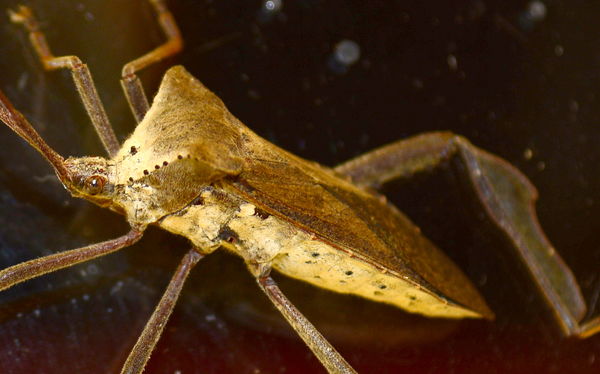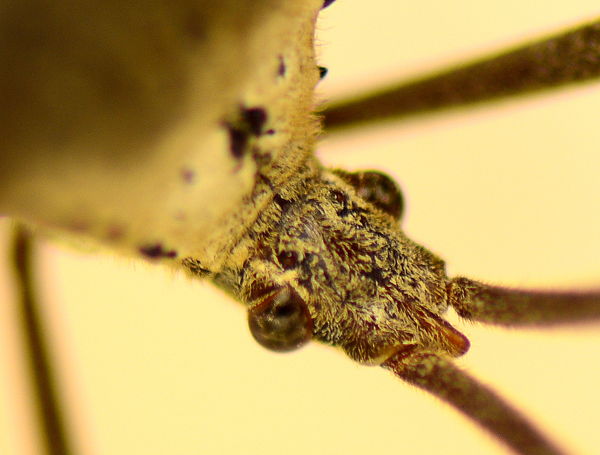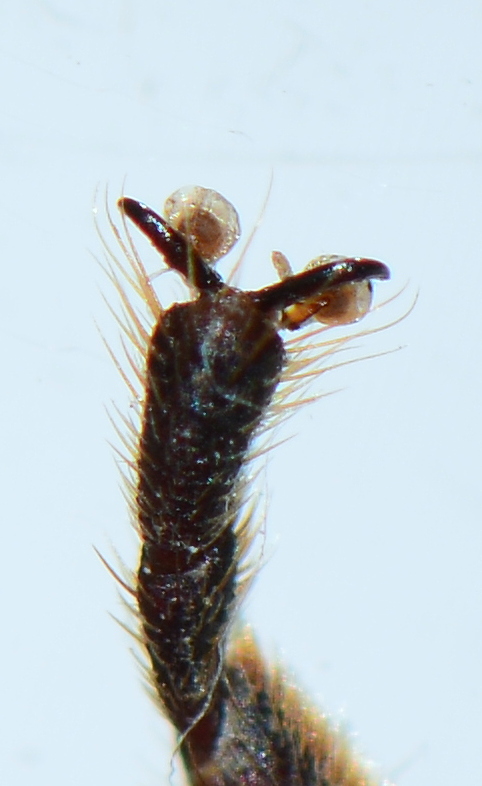Check out Film Photography section of our forum.
Some Stuff about Beginning Macro Work
Feb 1, 2015 21:08:42 #
My Stuff About Macro Work
This 'stuff' comes from the mind of Bugz; I know all the good photographers have learned far more than this but sometimes I see beginners wishing for just such posts to save the time and wasted experience that would be required to learn how to start doing macro work. Hope this helps them. There are many exceptions to these suggestions . . . but all in all this is my practice:
(1): Plenty of light. Probably more important than stabilizing the camera. The more light the better for those faster shutter speeds and smaller apertures . . . However! An under exposed picture is far more easily post shopped than an overexposed picture. Dont be afraid to use the flash even in daylight. Always try to force the picture any way possible with 100 ISO or the lowest possible ISO in all circumstances. The higher the ISO, the less the resolution.
(2): Absolutely stable camera. Use tripod, sandbag, prop, anything is better than trying to hand-hold a macro shot. Study and use the camera self timer; remote release; delayed shutter release (my D5200 NIKON has a feature to delay shutter opening for a split second even after the mirror flips). Turn OFF Vibration Reduction for shooting macros of still subjects.
(3): If shooting table top macro, be mindful of vibrations caused by fans, loud noises, floor shake, etc.. Let things settle before the shutter opens.
(4) If small aperture doesnt achieve enough depth of field , back off and do the most perfect shot possible then try cropping later. I use a 105 Nikkor Micro and often have to do this little trick with larger insects in order to gain acceptable focus (DOF) over the whole bug body.
(5) One great advantage of digital photography is that we can shoot many attempts for a total cost of zero! When it becomes necessary to try macro work while hand-holding the camera, try setting the camera to take 3 shots in fast succession, then learn to wait for all three exposures to complete before relaxing and breathing again. Youve got three chances of getting a fairly still shot. Just delete all unwanted stuff in the computer.
(6) Dont sell your kit lenses short. I have the usual 18-55mm & 55-200mm NIKON kit lenses and have done some very acceptable macro work with both when conditions are optimal. Also Ive learned that wild flower pictures from the drivers window, using the 55-200mm often is very acceptable for this old 79 year old back. Just be sure youre on a desolate road and turn off the engine if youre going to use the partially lowered window for a prop. Youd be surprised what detail you can get of that pretty little wild flower across the road. Let the wife watch behind for the surprise approaching vehicle. Dont irritate folks who may have a job just because youre not in a hurry.
*****
This 'stuff' comes from the mind of Bugz; I know all the good photographers have learned far more than this but sometimes I see beginners wishing for just such posts to save the time and wasted experience that would be required to learn how to start doing macro work. Hope this helps them. There are many exceptions to these suggestions . . . but all in all this is my practice:
(1): Plenty of light. Probably more important than stabilizing the camera. The more light the better for those faster shutter speeds and smaller apertures . . . However! An under exposed picture is far more easily post shopped than an overexposed picture. Dont be afraid to use the flash even in daylight. Always try to force the picture any way possible with 100 ISO or the lowest possible ISO in all circumstances. The higher the ISO, the less the resolution.
(2): Absolutely stable camera. Use tripod, sandbag, prop, anything is better than trying to hand-hold a macro shot. Study and use the camera self timer; remote release; delayed shutter release (my D5200 NIKON has a feature to delay shutter opening for a split second even after the mirror flips). Turn OFF Vibration Reduction for shooting macros of still subjects.
(3): If shooting table top macro, be mindful of vibrations caused by fans, loud noises, floor shake, etc.. Let things settle before the shutter opens.
(4) If small aperture doesnt achieve enough depth of field , back off and do the most perfect shot possible then try cropping later. I use a 105 Nikkor Micro and often have to do this little trick with larger insects in order to gain acceptable focus (DOF) over the whole bug body.
(5) One great advantage of digital photography is that we can shoot many attempts for a total cost of zero! When it becomes necessary to try macro work while hand-holding the camera, try setting the camera to take 3 shots in fast succession, then learn to wait for all three exposures to complete before relaxing and breathing again. Youve got three chances of getting a fairly still shot. Just delete all unwanted stuff in the computer.
(6) Dont sell your kit lenses short. I have the usual 18-55mm & 55-200mm NIKON kit lenses and have done some very acceptable macro work with both when conditions are optimal. Also Ive learned that wild flower pictures from the drivers window, using the 55-200mm often is very acceptable for this old 79 year old back. Just be sure youre on a desolate road and turn off the engine if youre going to use the partially lowered window for a prop. Youd be surprised what detail you can get of that pretty little wild flower across the road. Let the wife watch behind for the surprise approaching vehicle. Dont irritate folks who may have a job just because youre not in a hurry.
*****
Acanthocephalus sp.

Dorsal view of head of Acanthocephalus

Tarsus of Acanthocephalus

Feb 1, 2015 21:21:10 #
Feb 1, 2015 21:23:29 #
Check out Travel Photography - Tips and More section of our forum.
Feb 1, 2015 21:28:20 #
Feb 1, 2015 21:36:48 #
Bugz wrote:
My Stuff About Macro Work br br This 'stuff' come... (show quote)
Add to this that it is better to use a longer focal length and to be able to stay farther from subject. Short focal lengths tend to shade the subject, and they tend to scare away the subject.
And macro lenses tend to produce a flatter plane of focus than normal lenses. You can also add an extension tube to a macro lens to get the subject closer if need be.
Feb 1, 2015 21:57:19 #
For any photographer interested in macro-photography, I invite you to view the UHH True Macro-Photography Forum at http://www.uglyhedgehog.com/s-102-1.html . This is the forum to ask questions or discuss macro equipment and macro techniques, as well as share macro images.
Before posting macro images to the Macro Forum, please read Introduction to True Macro-Photography Forum at http://www.uglyhedgehog.com/t-22447-1.html . Each & every thread must contain at least one true macro-photograph.
To place Macro Forum on your UHH home page, you can subscribe here: http://www.uglyhedgehog.com/section_list.jsp .
Before posting macro images to the Macro Forum, please read Introduction to True Macro-Photography Forum at http://www.uglyhedgehog.com/t-22447-1.html . Each & every thread must contain at least one true macro-photograph.
To place Macro Forum on your UHH home page, you can subscribe here: http://www.uglyhedgehog.com/section_list.jsp .
Feb 2, 2015 06:17:49 #
Acanthocephalus? That's a family of parasitic worms. Could that be a stink bug? Pentatomidae, the family of shield or stink bugs. Got you by 2 years, youthful 79-year-old.
Feb 2, 2015 08:50:20 #
Great shots Bugz. I've been working at this with my Odes especially terminal appendages for IDs. I guess I really need a lot more practice.
-Doc
-Doc
Feb 2, 2015 09:03:32 #
Thanks for all the good advice, but the thing that always amazes me most about macro photography is to discover how furry insects actually are!! :)
Feb 2, 2015 12:47:07 #
revhen wrote:
Acanthocephalus? That's a family of parasitic worms. Could that be a stink bug? Pentatomidae, the family of shield or stink bugs. Got you by 2 years, youthful 79-year-old.
revhen: ____ Wow, you are close enough to get an A! You are correct that genus Acanthocephala also includes those spiny headed parasitic round worms. That sparked an ancient memory of mine from academics in tropical medicine. I love the Greek and Latin roots. Your comment moved me to look into the Greek derivation of the word. Knowing that cephala refers to the head, I moved on to acantha which was still alien to me in its Greek root. It is rich in Greek mythology while simply meaning spinous or thorny. Acantha is found in nomenclature of both animal and plant life; and now I find, even architecture, furniture form, and Greek mythology. It was an exciting learning trip for me because of your post that sparked it. Youll never find a worthy entomologist who will brag about his expertise . . . because we are so often corrected by advancing changes in taxonomical methods and new found species. And besides, when over a million of the critters have been described so far, who could know it all!
Now to clarify my bug (and it IS a true bug of the Order Hemiptera as opposed to other insect categories):
Kingdom: Animalia
Phylum: Arthropoda
Class: Insecta
Order: Hemiptera
Suborder: Heteroptera
Family: Coreidae . . . (Not Pentatomidae)
Genus: Acanthocephala
Species: A. declivis
Binomial name
Acanthocephala declivis
One common name is Pumpkin Bug.
The antennae of the more commonly called stink bugs (Family Pentatomidae) have five segments in the antenna; this family, poor things, can only afford four. Cest la vie.
Thanks for your post.
Feb 2, 2015 13:05:41 #
docshark; I love the dragonflies too. Been thinking of making a 'specific collection' of Odonata, but usually yield to 'whatever comes along'. More often lately if it moves, I chunk it in a big jug and take it home to photographic live. I'm learning that a live specimen gives a much preferred macro in most cases. Tks for the post.
Check out Commercial and Industrial Photography section of our forum.
Feb 2, 2015 13:35:45 #
Bugz wrote:
revhen: ____ Wow, you are close enough to get an ... (show quote)
Glad I stirred those "little gray cells" (Poirot). I am much more of an etymologist than an entomologist. As a "retired" Presbyterian minister who still does considerable preaching around, I get into the Greek to clarify certain passages. Recently (age 80) wrote a paper and delivered a talk on the music of the Beatles. All this and UHH keeps my little grey cells stirring.
P.S. I have a degree in chemistry from Carnegie-Mellon University so I have some scientific background.
Feb 2, 2015 13:48:41 #
revhen wrote:
Glad I stirred those "little gray cells"... (show quote)
*****
Again you spark old memory: It was Professor Faye Erasius Guyton at Auburn (Polytechnic Institute for most of my academics) University who once told me: "Son if you ever hope to become a vast entomologist; you must first become at least a half-vast etymologist." Nothing ever more true.
Feb 2, 2015 14:13:27 #
Bugz wrote:
*****
Again you spark old memory: It was Professor Faye Erasius Guyton at Auburn (Polytechnic Institute for most of my academics) University who once told me: "Son if you ever hope to become a vast entomologist; you must first become at least a half-vast etymologist." Nothing ever more true.
Again you spark old memory: It was Professor Faye Erasius Guyton at Auburn (Polytechnic Institute for most of my academics) University who once told me: "Son if you ever hope to become a vast entomologist; you must first become at least a half-vast etymologist." Nothing ever more true.
Frankly I've met more people who have more in common with me than practically anywhere else.
Feb 2, 2015 14:21:47 #
@ Bugz, I'm curious why we don't see you over in the "True Macro" forum. It would seem all could benefit from collective experience :wink:
If you want to reply, then register here. Registration is free and your account is created instantly, so you can post right away.
Check out Black and White Photography section of our forum.








